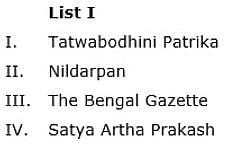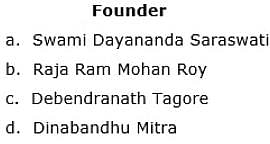TS SET Paper 2 Mock Test - 1 (History) - TS TET MCQ
30 Questions MCQ Test TS SET Mock Test Series 2024 - TS SET Paper 2 Mock Test - 1 (History)
How many Princely states were present during the 1947
Which of the following statements is not correct in respect to James Mill and imperialist historiography?
Which dynasty ruled in the region of modern Haryana at the time of Ghaznavid's invasion?
Consider the following statements with reference to Permanent Settlement:
1. It was implemented in almost 53% of India.
2. Ownership of land was constantly changing.
Which of the above statements is/are correct?Assertion: Lord Rippon followed spirited forward policy towards Afghanistan
Reason: Lord Rippon dumped erstwhile policy of "Masterly Inactivity"
With reference to the history of philosophical thought in India, consider the following statements regarding Sankhya school :
1. Sankhya does not accept the theory of rebirth or transmigration of soul.
2. Sankhya holds that it is the self – knowledge the leads to liberation and not any exterior influence or agent.
Which of the statements given above is / are correct?
As per the Government of India Act of 1919, the appointment of the Simon Commission was scheduled in which year?
Match List I with List II, and select the correct answer by using the codes given below the lists:
List I
I. Jawaharlal Nehru
II. Sardar Patel
III. J.B. Kripalani
IV. Dr. Rajendra Prasad
List II
a. States Committee
b. Provincial Constitution Committee
c. Steering Committee
d. Fundamental Rights Sub-Committee
Codes:
consider the following statement about Junagarh Inscription :
1. The earliest specimen of the Kavya style was found in the Junagarh Inscription.
2. This inscription was made under the rule of Rudradaman 1.
3. This inscription was written in the Prakrit language.
Which of the statements given above is/are correct?
Consider the following options.
1. The fifth report submitted to the British Parliament in 1813 AD.
2. Jotedars were quite powerful.
3. Santhals were a great danger to Paharis.
4. No Zamindari was auctioned in Bengal.
With reference to the Khaksars, consider the following statements.
1) It was aimed at freeing India from the rule of the British Empire and establish a Hindu-Muslim government in India.
2) They were the Khaki uniform wearing quasi-military organisation of the Muslims.
3) They carried spades with them.
Choose the incorrect statements.
The correct chronology of the conquests of Alauddin Khilji is:
(i) Conquest of Chittorgarh
(ii) Conquest of Gujarat
(iii) Conquest of Ranthambore
(iv) Second Campaign of Devgiri
Arrange the following events in their chronological order and select the correct answer from the codes given below:
A. Hunter Commission
B. Saddler Commission
C. Wood's Despatch
D. Sargent Plan
Which of the following acts was passed after the agitation of the Moderates of INC?
Choose the correct pair.
- Hindustan People’s Republican Party:- a secret society founded in London.
- Shyamaji Krishnaverma:- first revolutionary organization at all India level.
Consider the following statements about the scripts used in the Ashokan inscriptions :
1. Kharosthi script was written from left to right.
2. Brahmi script was written from right to left.
3. Greeks changed their horizontal writing direction from right-to-left to left-to-right for better efficiency.
Which of the statements given above is/are correct?
The Indian National Congress (INC) underwent ideological shifts throughout its history. Among the following statements regarding the INC's ideologies and programs, which are CORRECT?
(a) In the early 20th century, the INC adopted a more radical stance, advocating for complete independence through mass civil disobedience movements led by Mahatma Gandhi.
(b) After independence, the INC pursued a socialist economic model with centralized planning and state control of key industries.
(c) Despite its commitment to secularism, the INC sometimes faced challenges in balancing the interests of different religious communities in India.
Indian Jute Mills Association was established in which year?
What was the ratio of the Indian sepoys to the Europeans in the British Indian Army on the eve of the outbreak of the Revolt of 1857?
With reference to the system of ‘Subsidiary Aliances’, consider the following statements.
1) Under this system, the ruler of the allying Indian state was to be provided with the British defence forces only when required.
2) The ruler also sometimes ceded part of his territory instead of paying annual subsidy.
3) The ruler could employ any European in his service at his court.
Choose the incorrect answer
Which of the following is the correct timeline of the “policy of the equal federation”?
Among the given options, which of the following is the correct match for Prarthana Samaj, Young India, Lokhitvadi, Satyashodhak Samaj and Rehnumai Mazdayasan Sabha, respectively?
|
60 tests
|






















